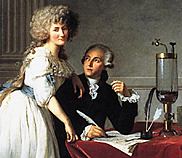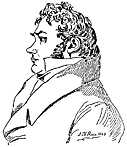Risky conclusions and Naming protocols
![]()
![]()
It is probably painfully obvious to all readers that the product of humans is typically no better than the quality of their thinking. One common flaw is caused by jumping to conclusions before key information is known. That said, it should also be noted that we often need a conclusion before all possible information can be gathered. The challenges of when to draw a conclusion and what conclusion is reasonable require wisdom which unfortunately accumulates after much education, experience, and age. At least being cautious can be taught.
In recent years there has been concern about a group of substances containing the perchlorate ion. Ammonium perchlorate is used to produce solid rocket propellents. The Defense Department, NASA, and their contractors are believed to be responsible for much, though not all, of the perchlorate contamination since they use 90% of the perchlorate produced in the United States. It was discovered to have seeped into groundwater and surface water and subsequently found in foods such as lettuce and milk. Once ingested in mammals such as humans, it inhibits the transport of iodide ions, the lack of which can result in hypothyroidism. As a result the United State government (EPA) had proposed a concentration limit of 1 ppb (part per billion) for drinking water and proposed that industries which use perchlorate should be held accountable for the perchlorate found in the environment. In 2005, the National Research Council established that 0.7 μg per kg of body weight per day is a safe dose, even for unborn children (the most vulnerable) carried by women who have Iodine-deficient diets or whose bodies don't make enough thyroid hormone. Perchlorate has been found in lettuce and melons which were likely irrigated with perchlorate-tainted water, or were grown in soils where the chemical occurs naturally or that were treated with perchlorate-containing fertilizer. Perchlorate also has been found in cows' milk, presumably because these animals drink water or eat feed contaminated with perchlorate.
Researchers at the National Center for Environmental Health detected perchlorate in urine from each of the 2,820 participants who were at least six years old in its National Health & Nutrition Examination Study for 2001-02. They also found that concentrations of perchlorate in children were generally higher than levels found in adolescents and adults. Researchers also discovered that perchlorate exposure was associated with a decreased level of thyroid hormone among women with lower than normal concentrations of Iodine in their urine. Iodine is essential for the production of thyroid hormone, which regulates the body's metabolism. Perchlorate interferes with the thyroid's uptake of Iodine. An estimated 43 million women in the U.S. have Iodine levels low enough to put them at increased risk of developing goiter, an enlargement of the thyroid gland due to an insufficient amount of thyroid hormone.
If these women with low Iodine concentrations become pregnant, their babies could risk abnormal brain development. The developing nervous system is sensitive to small changes in thyroid hormone levels. During the first trimester an embryo is completely dependent on maternal thyroid hormone. After that, the fetus begins to produce its own thyroid hormone but still receives about 30% of its total from the mother for the remainder of the pregnancy. Nursing infants also are vulnerable to neurological problems from perchlorate exposure. An infant can get perchlorate in breast milk and that also inhibits the movement of Iodine into breast milk, creating double jeopardy for the nursing infant.
Since NASA and the military face a potentially huge liability for cleanup if the government requires the removal of perchlorate from drinking water, they are seeking evidence that they are not responsible. For example, fertilizer high in nitrates earlier imported from Chile might also have produced the perchlorates.
And perchlorate was discovered at unexpectedly high concentrations in areas where human caused pollution was very unlikely, evidence that nature itself can apparently also produce perchlorates. In 2004 a group of chemists led by Andrew Jackson and Purnendu K. Dasgupta surveyed ground water under 60,000 square miles of Texas and New Mexico finding perchlorate concentrations as high as 60 ppb. In a follow-up study they found the concentrations in the high plains correlated with concentrations of iodate known to come from the atmosphere. To try to determine if a similar mechanism produced the percholorate, they exposed aerosols of sea salt (tiny specks of salt suspended in the air) to high voltage electrical discharges. Perchlorates were formed. They found high concentrations of ozone, a substance created by lightning (see lab E1 and lab E4) can produce the perchlorates. Rain and snow samples also contain perchlorates. They propose that lightning (high voltage electrical discharges) striking salt carried by winds from the oceans or desert salt flats is responsible for creating at least some of the perchlorates.

The description about contains a number of related chemical names such as iodide and iodate. Perhaps it would be appropriate here to describe the system used to name such substances. Much of the system of nomenclature used today dates back to the new chemistry of Antoine Lavoisier (1743-1794 at right with wife, Marie), his colleague Louis Bernard Guyton de Morveau (1737-1816) and others as introduced in Méthode de nomenclature chimique in 1787.
| description | name | example |
| acid saturated with Oxygen | ending: -ique (French), -ic (English) | acidic sulfurique, sulfuric acid |
| salt from above acid | ending: -ate | sulfate |
| acid with less Oxygen | ending: -eux (French), -ous (English) | acidic suflureux, sulfurous acid |
| salt from above acid | ending: -ite | sulfite |
| non-acidic compound | ending: -ide | sulfide |
Such new nomenclature had been proposed by Morveau since 1780 but did not garner much enthusiasm. Lavoisier published Traité élémentaire de chimie in 1789 systematically presenting how the new vocabulary, the new Oxygen theory and the new definition of elements explained much that was previously known about substances and their reactions. In the preface Lavoisier emphasized the importance of language to clear thinking, a point previously stressed by the philosopher de Condillac (1715-1780). This new book was translated to most of the other European languages and finally brought about the intended revolution in chemistry.
The system was improved by Jöns Jakob Berzelius (1779-1848 at right), particularly in 1813 with one and two letter symbols based on the Latin names of the elements (such as Cl for Chlorine and I for Iodine). Names for substances with more or less Oxygen were indicated by adding prefixes per- or hypo-.
| description | name | example |
| salt with even more Oxygen | prefix: per- | persulfate |
| salt with even less Oxygen | prefix: hypo- | hyposulfite |
| name | symbol | name | symbol | |
| sulfate | SO4-2 | SO3-2 | ||
| chlorate | ClO3-1 | bromate | BrO3-1 | |
| chlorite | iodate | |||
| hypochlorite | phosphate | PO4-3 | ||
| perchlorate | PO3-3 | |||
| chloride | Cl-1 | nitrate | NO3-1 | |
| I-1 | oxide | |||
| NO2-1 | carbonate | CO3-2 | ||
| F-1 | SiO3-2 |
Communicating technical information such as observations and findings is a skill used by scientists but useful for most others. If you need course credit, use your observations in your journal to construct a formal report.
![]()
to next experiment
to Environmental Chemistry menu
to ie-Chemistry menu
to site menu